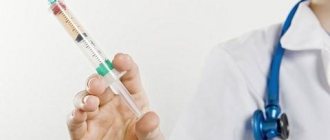With high blood pressure, the patient requires medical attention. The sooner the patient goes to the clinic, the sooner the course of treatment for hypertension will begin. With regular high blood pressure, doctors prescribe antihypertensive drugs. There are many different drugs on sale that belong to different pharmacological groups, so a specialist is responsible for selecting medications. Among the antihypertensive drugs, Farmadipin drops stand out, which are calcium antagonists. Farmadipin drops help with blood pressure, they are highly effective and well tolerated by patients.
Brief information about the drug
Release form
The drug is produced in the form of green drops with a pronounced characteristic odor and taste. Farmadipin drops are bottled in 5 or 25 ml bottles. Additionally, glass ampoules are packed in cardboard boxes. One pack contains one ampoule. The kit includes instructions for using Farmadipin.
Composition of the drug
1 ml of Farmadipin drops contains 20 mg of the main active ingredient nifedipine.
Other drop components:
- ethanol;
- polyethylene glycol.
Packaging of Farmadipin drops
pharmachologic effect
The drug Farmadipin has an antihypertensive and antianginal effect.
, Kyiv, Ukraine
Terms and conditions of storage
It is recommended to store the drug in accordance with the instructions for use. The place for storing drops should be inaccessible to children, the storage temperature does not exceed 25 degrees.
The shelf life of the drops is 3 years from the date of manufacture. After the expiration date, the drug cannot be used. It must be disposed of in accordance with sanitary standards.
Conditions for dispensing from a pharmacy
The drug is sold in pharmacies with a prescription from the attending physician.
Price
Drops of 5 ml will cost 100-110 rubles. The cost of a 25 ml bottle of Farmadipin is 120-130 rubles.
The drug belongs to the group of calcium channel blockers
Drug interactions
The instructions do not recommend using Farmadipin simultaneously with rifampicin and macrolide antibiotics. In addition, simultaneous use of antiepileptic drugs can reduce the concentration of the active substance Farmadipin in the blood, reducing its effectiveness. If it is used together with other antihypertensive drugs, severe arterial hypotension develops. In addition, it is not recommended to drink grapefruit juice while taking Farmadipin, as it enhances the effect of the drug.
Pharmacokinetics of the drug
Drops are intended for oral administration. They are quickly absorbed from the gastrointestinal tract, bioavailability exceeds 50%. Farmadipine quickly reduces blood pressure: when taken sublingually, the effect is noticeable within 5-10 minutes.
The maximum concentration is achieved 30-40 minutes after using the drops. The drug lasts 5-6 hours. Binding to blood proteins is more than 90%. Metabolism occurs in the liver. The half-life is 2-4 hours.
In old age and in patients with liver dysfunction, the half-life doubles, so patients require dose adjustment and frequency of administration.
No accumulative effect was found. The components of the drug penetrate into breast milk, through the placenta and the blood-brain barrier.
Contraindications
Contraindications to the use of the drug Farmadipin are: acute myocardial infarction (first 4 weeks); cardiogenic shock; severe aortic and mitral stenosis; unstable angina; do not use for the treatment of angina attacks, secondary prevention of myocardial infarction; heart failure in the stage of decompensation; arterial hypotension (systolic blood pressure below 90 mmHg); ventricular tachycardia with widened QRS complex; sick sinus syndrome; Wolff-Parkinson-White syndrome (WPW), Lown-Genong-Levine syndrome (LGL); AV block II and III degrees; porphyria; ileostomy installed after proctocolectomy; pregnancy; breastfeeding period; childhood; hypersensitivity to nifedipine and other components of the drug; hypersensitivity to other dihydropyridines; Do not take simultaneously with rifampicin.
Use during pregnancy and lactation
The drug Farmadipin should not be taken for blood pressure by women during pregnancy, especially in the first trimester. The drug is prescribed during gestation only if treatment is appropriate and other methods of therapy are unacceptable. Before prescribing drops, the doctor calculates the potential risk to the health of the mother and child.
The components of the drops penetrate into breast milk in small quantities, therefore breastfeeding should be stopped during the period of therapy with Farmadipin.
Drops are contraindicated for pregnant women and nursing mothers
Mode of application
In case of a sudden and severe increase in blood pressure, adult patients should drop three to five drops of Farmadipin under the tongue. You can also drop this drug onto a piece of refined sugar and hold it in your mouth until completely dissolved. Elderly people should not take more than three drops of this medicine at a time.
If the drug shows insufficient effectiveness, the dose can be increased to a clinically significant effect. For further attacks of hypertension, it is necessary to focus on this dose. The maximum dose should be 10 to 15 drops. It should be noted that some individuals have hypersensitivity to Farmadipin.
For them, the dose should start with three drops and gradually increase by 2-3 drops until a clinical effect is achieved.
If the initial dose of the drug is significantly exceeded, this can lead to a sharp decrease in blood pressure.
The drug is effectively used for angina pectoris, find out more about the symptoms and treatment of this disease:
- Modern methods and methods of treating angina pectoris.
- Signs and symptoms of Angina.
Instructions for use and dosage
Farmadipine is prescribed for high blood pressure in emergency cases, when there is a possibility of a hypertensive crisis. A course of medication is not advisable.
The emergency drug is taken sublingually for sudden surges in pressure. The recommended dosage is 3 drops. For ease of administration, drops can be applied to a sugar cube or a slice of bread, then placed under the tongue and slowly dissolved.
If the indicated dosage does not bring relief, the pressure increases, you can slightly increase the dosage from 3 to 5 drops. With further pressure surges, it is recommended to start therapy with a selected effective dose. The maximum single dosage is 10-15 drops.
Farmadipine should be taken for high blood pressure only as prescribed by a doctor. It is necessary to start therapy with a minimum dose, since the drug can cause allergies. If the dosage is incorrectly selected, the pressure can drop to critical levels.
Overdose
An overdose occurs whenever the permissible dose of a drug exceeds the prescribed minimum.
Since the drug is intended for emergency use, in the event of an overdose, blood pressure can drop to a minimum level in a fairly short period of time.
As a result, tremors or numbness of the extremities, dizziness, nausea, fainting, and vomiting may occur. More severe consequences are also possible in the form of coma, pulmonary edema, hypoglycemia, hypoxia and many other manifestations, which will depend on the individual characteristics of the body.
If the norm is exceeded, it is necessary to take urgent medical measures, including gastric lavage, taking activated charcoal, as well as medications intended to normalize heart rate and blood pressure. After taking measures, consultation and examination by a specialist is advisable.
Side effects
Taking Farmadipin with high blood pressure may cause unwanted reactions in the body. Main side effects:
- nervous system: increased anxiety, sleep disturbances, headaches, vestibular disorders, trembling limbs, migraine, drowsiness, sensory disturbance: hypersensitivity, numbness, fainting;
- circulatory system: increased blood glucose, decreased level and number of leukocytes, nosebleeds, decreased blood pressure, vasodilation;
- respiratory system: shortness of breath, runny nose;
- cardiovascular system: increased heart rate, angina, swelling;
- allergic reactions: Quincke's edema, nettle fever, rash, anaphylaxis;
- urinary system: increased urine production, impaired urination;
- organs of perception: blurred vision, pain in the eyes;
- musculoskeletal system: seizures, joint swelling, muscle pain, joint pain;
- gastrointestinal tract: difficulty defecating, epigastric pain, vomiting, bloating, dry mucous membranes, impaired swallowing function, intestinal obstruction, intestinal ulcer, overgrowth of gum tissue, stones in the stomach;
- liver: increased enzyme activity, yellowing of the skin;
- skin: Lyell's syndrome, Werlhof's disease, photosensitivity, erythema;
- reproductive system: decreased libido, impotence.
Pharmadipine may cause sleep disturbances
Side effects
If you follow the recommendations for the use of the drug Farmadipin , side effects are minor and transient, as a rule, do not require discontinuation of therapy. With frequent and uncontrolled use, adverse reactions characteristic of drugs of this pharmacological group are possible. From the cardiovascular system: often - edema, vasodilation, infrequently - tachycardia, increased heart rate, arterial hypotension, syncope. From the central and peripheral nervous system: often – headache; uncommon – vertigo, migraine, dizziness, tremor, sleep disorder, anxiety; rarely - short-term visual impairment, agitation, paresthesia, dysesthesia. From the endocrine system: hyperglycemia (should be taken into account in patients with diabetes mellitus). From the digestive system: often – constipation; infrequently, when using higher doses, abdominal pain, dyspeptic symptoms, flatulence, nausea, vomiting (very rare), gingival hyperplasia (with long-term use), dry mouth, transient increase in liver enzymes occur. From the urinary system: infrequently – polyuria, dysuria. From the hematopoietic system: rarely – anemia, leukopenia, thrombocytopenia. Allergic reactions: uncommon - allergic reaction, allergic edema/angioedema (including laryngeal edema); rarely – itching, urticaria, rash; very rarely - anaphylactic/anaphylactoid reactions. Others: often – feeling unwell; uncommon – nosebleeds, nasal congestion, erythema; rarely - swelling of the lower leg, muscle cramps, swelling of the joints, erectile dysfunction, nonspecific pain, fever, dyspnea.
Drug overdose
If the prescribed dose is violated and increased without a doctor’s prescription, an overdose of Farmadipin components from pressure may occur, which is expressed in the appearance of characteristic symptoms:
- a sharp drop in blood pressure to critical levels;
- increased heart rate;
- sinus rhythm disturbance;
- oxygen starvation;
- violation of acid-base balance;
- clouding of consciousness;
- coma;
- pulmonary edema.
To eliminate signs of overdose, you should rinse your stomach. It is necessary to stabilize the general condition, normalize blood pressure and other indicators.
For further treatment, you should call a doctor. The doctor will prescribe symptomatic therapy. Hemodialysis is ineffective.
Indications and effect
Drops for high blood pressure Farmadipin are taken when there is a threat of hypertensive crises, when corresponding symptoms are detected (high blood pressure, headache, dizziness, tremors of the limbs, and so on).
A course of treatment using drops is not allowed, since Farmadipin is classified as an emergency medicine.
Farmadipin drops
After administration, spasm is relieved, vascular smooth muscle relaxes, peripheral resistance is eliminated and myocardial oxygen demand is reduced. As a result, there is a decrease in blood pressure, as well as an improvement in the general condition of the patient.
As a result, the risk of irreversible processes in organ tissues, which are an integral part of a hypertensive crisis, is reduced, and the risk of heart attacks and strokes is also reduced.
special instructions
Farmadipin should not be taken by patients with high blood pressure after ileostomy. After using the drops, you should not do a contrast X-ray examination of the stomach and intestines, as the results may be incorrect.
In case of heart failure with low blood pressure, drops should be taken with extreme caution under the supervision of a physician.
When the gastrointestinal tract narrows, chronic obstructive disease may develop. Bezoar stones, requiring surgical intervention, appear in isolated cases.
If the patient has severe liver dysfunction, a dose adjustment is required. The doctor must constantly monitor the functioning of the organ.
The drug affects the quality and motility of sperm; taking drops can cause impotence or decreased libido.
If the use of drops during a hypertensive crisis provokes ischemia or angina, Farmadipin cannot be used for high blood pressure in the future.
Patients on hemodialysis, with low blood pressure and reduced circulating blood volume should take the drug with caution, monitoring the functioning of the internal organs.
Diabetics may need to adjust their insulin dose.
Taking the blood pressure drug Farmadipin can cause a slowdown in psychomotor reactions, decreased concentration, and blurred vision, so in the first days of taking it you should avoid driving vehicles and performing work that requires increased alertness and activity.
In the first days of taking it, you should avoid work that requires concentration.
Undesirable symptoms
The following negative effects may develop from taking Farmadipin:
- sleep disturbances, anxiety;
- increased blood glucose levels;
- leukopenia, agranulocytosis;
- nasal congestion, bleeding;
- headache, dizziness, migraine;
- deterioration of visual function;
- cramps, muscle and joint pain, joint swelling;
- hives, rash;
- disturbance of the rhythm and frequency of heart contractions, “angina pectoris”;
- drop in blood pressure, loss of consciousness;
- pain in the epigastric region;
- nausea, flatulence;
- ulcerative intestinal lesions, intestinal obstruction;
- fever;
- jaundice;
- stool disorders;
- decreased libido;
- dry mucous membranes.
Pharmacological interactions
Farmadipin drops cannot be taken with some drugs due to a violation of the pharmacokinetic and pharmacodynamic properties:
- Digoxin's elimination rate decreases and its blood content increases;
- the bioavailability of azole antimycotics increases;
- other antihypertensive drugs, diuretics, ACE inhibitors, beta-blockers, calcium channel blockers, Methyldopa tablets, magnesium sulfate require dosage reduction due to increased effectiveness;
- the concentration of Quinidine in the blood decreases;
- The therapeutic effect of Tacrolimus may change, so dose adjustment is required.
Other medications affect the pharmacological properties of Farmadipin drops:
- Rifampicin reduces the bioavailability of drops;
- Cimetidine increases the content of components in the blood, increases the hypotensive effect of drops;
- macrolide antibiotic drugs slow down the metabolic rate;
- highly active antiretroviral therapy reduces the effectiveness of drops;
- Valproic acid, Nefazodone, Fluoxetine, Quinupristin, Cisapride increase the concentration of Farmadipin components in the blood;
- anticonvulsants, Carbamazepine, Phenobarbital reduce the content of Farmadipin in the blood.
Metabolism occurs with the participation of the CYP3A4 system, therefore, when using Farmadipin drops and drugs that affect the functioning of the cytochrome P450 system, it is recommended to exercise special caution.
When taking Farmadipin, you must avoid grapefruit juice or the fruit itself, as it reduces clearance, increases the concentration of components in the blood, and increases the duration of action of the drops. After drinking grapefruit juice, the effect of taking the drug lasts for three days.
Farmadipine may be incompatible with other drugs
Interaction
Dihydropyridines are metabolized by cytochrome P450 3A4 (CYP3A4). The simultaneous use of inhibitors of this enzyme can significantly increase the concentration of nifedipine in the blood. CYP3A4 is inhibited by amiodarone, antifungal drugs, and some macrolides (erythromycin, clarithromycin).
Erythromycin
Concomitant administration of nifedipine with CYP3A4 inducers leads to a decrease in the concentration of the drug in the blood.
Nifedipine may increase the concentration of some statins (simvastatin, lovastatin), macrolide antibiotics, amiodarone, steroid hormones and cytostatics in the bloodstream.
The combination of nifedipine with other drugs is most often used for hypertension. Dihydropyridines can be combined with other commonly used antihypertensive agents. The only exceptions are the non-dihydropyridine drugs verapamil and diltiazem. It is strictly forbidden to combine drugs with beta blockers, especially metoprolol.
Important! The latter two CCBs should not be administered to patients with heart failure or symptomatic ventricular dysfunction.
Pharmacological composition
The drug contains nifedipine, polyethylene glycol, ethanol.
The medicine is available in dosages of 5 ml and 25 ml.
Pharmacology
- Taken to relax vascular smooth muscles,
- Eliminates spasm of blood vessels and arteries,
- Normalizes blood pressure,
- Saturates the tissues of the heart muscles with oxygen,
- Reduces platelet aggregation in the blood.
Refers to antihypertensive and antianginal drugs. The drug acts in the body for 6 hours.
Pharmacological properties
Farmadipin drops: instructions for use indicate that the mechanism of action of the drug at the cellular level is to block the free flow of calcium ions to the membranes of cardiomyocytes. Nifedipine drops block the calcium channels of smooth muscle cells that are located in the walls of the arteries, which prevents their narrowing and increased pressure.
Due to the fact that the coronary vessels remain dilated, the blood flow through them is not disturbed, which becomes the key to a complete blood supply to the tissues of the heart, in particular the myocardium. The trophic needs of the cells are satisfied, and oxygen starvation does not occur. The use of Farmadipin drops reduces platelet aggregation and reduces blood viscosity. To a small extent reduces heart rate, reducing myocardial oxygen demand.
When taken orally, the solution is quickly absorbed into the blood through the mucous membrane of the gastrointestinal tract. The bioavailability of nifedipine is almost 50% of the dose taken, so the pharmacological effect after taking the medicine occurs within 5-7 minutes.
The peak action of Farmadipin occurs 40 minutes after use and lasts for 5-6 hours, since the drug binds well to transport proteins in the blood plasma and remains to circulate with them in the bloodstream for a long time.
According to the instructions, Farmadipin is metabolized in hepatocytes and is completely excreted from the body in feces after 3-4 hours. However, in elderly people, patients with liver failure and cirrhosis, the metabolic time doubles. This must be taken into account when prescribing for appropriate dosage adjustment.
Note! Farmadipin is able to overcome the blood-brain, placental and lactation barriers.
Clinical picture of an overdose of Farmadipin
An overdose of Farmadipine leads to hypotension, then the heart rate increases compensatoryly. As energy reserves in cardiomyocytes are depleted, bradycardia occurs, which leads to hypoxia.
Total oxygen starvation is accompanied by a change in metabolism in cells and the release of a large amount of under-oxidized metabolic products. Metabolic acidosis develops, that is, pH in tissues decreases, the work of enzymes that are necessary for normal interaction of cells with each other is disrupted.
Clinically, this is manifested by neurological symptoms ranging from dizziness and headache, ending with disturbances of consciousness such as stupor, stuporous state and coma. Then the internal organs begin to suffer. Acute conditions, such as pulmonary edema, are possible.
First aid for an overdose of Farmadipine is, first of all, to eliminate the etiological factor. You can remove excess amounts of the drug and its metabolic products by resorting to gastric lavage and taking sorbents. In parallel with this, measures are taken to increase blood pressure, for example, infusions of water-salt solutions, sympathomimetics: adrenaline, dopamine and calcium preparations.
If equipment and experienced specialists are available, plasmapheresis can be performed. This will clear the blood of albumin associated with Farmadipin.
Plasmapheresis device
Indications for use of Farmadipin
According to the guidelines for the use of Farmadipin, this drug is indicated only as an emergency aid to relieve a hypertensive crisis. It is strictly not recommended to take the drug in courses for a long time. If in rare cases treatment with Farmadipin is required on an ongoing basis, the form of the drug and dosage are selected by the doctor in each individual case.
Hypertensive crisis











